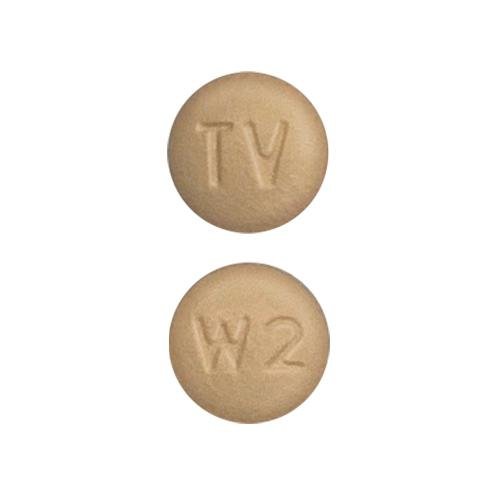Perampanel Dosage
Medically reviewed by Drugs.com. Last updated on Feb 27, 2024.
Applies to the following strengths: 2 mg; 4 mg; 6 mg; 8 mg; 10 mg; 12 mg; 0.5 mg/mL
Usual Adult Dose for:
Usual Pediatric Dose for:
Additional dosage information:
Usual Adult Dose for Epilepsy
Partial-Onset Seizures: Monotherapy or Adjunctive Therapy
Initial Dose: 2 mg orally once a day at bedtime
- Increase dose by increments of 2 mg/day no more frequently than once a week based on individual clinical response and tolerability
Maximum Dose: 12 mg/day
Primary Generalized Tonic-Clonic Seizures: Adjunctive therapy:
Initial Dose: 2 mg orally once a day at bedtime.
- Increase dose by increments of 2 mg/day no more frequently than once a week based on individual clinical response and tolerability
Maximum Dose: 12 mg/day
CONCOMITANT USE OF MODERATE OR STRONG CYP450 3A4 ENZYME INDUCERS:
Initial Dose: 4 mg orally once a day at bedtime
- Increase dose by increments of 2 mg/day no more frequently than once a week based on individual clinical response and tolerability
Maximum Dose: Highest dose studied 12 mg/day
Comments:
- At the higher dose of 12 mg/day, a somewhat greater reduction in seizure rates was observed than at 8 mg/day; however, a substantial increase in adverse reactions was reported.
- When moderate or strong CYP450 3A4 inducers are introduced or withdrawn from a patient's regimen, closely monitor clinical response and tolerability; dose adjustments may be necessary.
Uses: For the treatment of partial-onset seizures with or without secondarily generalized seizures and for the treatment of primary generalized tonic-clonic seizures in patients with epilepsy.
Usual Adult Dose for Seizures
Partial-Onset Seizures: Monotherapy or Adjunctive Therapy
Initial Dose: 2 mg orally once a day at bedtime
- Increase dose by increments of 2 mg/day no more frequently than once a week based on individual clinical response and tolerability
Maximum Dose: 12 mg/day
Primary Generalized Tonic-Clonic Seizures: Adjunctive therapy:
Initial Dose: 2 mg orally once a day at bedtime.
- Increase dose by increments of 2 mg/day no more frequently than once a week based on individual clinical response and tolerability
Maximum Dose: 12 mg/day
CONCOMITANT USE OF MODERATE OR STRONG CYP450 3A4 ENZYME INDUCERS:
Initial Dose: 4 mg orally once a day at bedtime
- Increase dose by increments of 2 mg/day no more frequently than once a week based on individual clinical response and tolerability
Maximum Dose: Highest dose studied 12 mg/day
Comments:
- At the higher dose of 12 mg/day, a somewhat greater reduction in seizure rates was observed than at 8 mg/day; however, a substantial increase in adverse reactions was reported.
- When moderate or strong CYP450 3A4 inducers are introduced or withdrawn from a patient's regimen, closely monitor clinical response and tolerability; dose adjustments may be necessary.
Uses: For the treatment of partial-onset seizures with or without secondarily generalized seizures and for the treatment of primary generalized tonic-clonic seizures in patients with epilepsy.
Usual Pediatric Dose for Epilepsy
Partial-Onset Seizures: Monotherapy or Adjunctive Therapy
4 years or older:
Initial Dose: 2 mg orally once a day at bedtime
- Increase dose by increments of 2 mg/day no more frequently than once a week based on individual clinical response and tolerability
Maximum dose: 12 mg/day
Primary Generalized Tonic-Clonic Seizures: Adjunctive therapy
12 years or older:
Initial Dose: 2 mg orally once a day at bedtime.
- Increase dose by increments of 2 mg/day no more frequently than once a week based on individual clinical response and tolerability
Maximum dose: 12 mg/day
CONCOMITANT USE OF MODERATE OR STRONG CYP450 3A4 ENZYME INDUCERS:
Initial Dose: 4 mg orally once a day at bedtime
- Increase dose by increments of 2 mg/day no more frequently than once a week based on individual clinical response and tolerability
Maximum Dose: Highest dose studied 12 mg/day
Comments:
- At the higher dose of 12 mg/day, a somewhat greater reduction in seizure rates was observed than at 8 mg/day; however, a substantial increase in adverse reactions was reported.
- When moderate or strong CYP450 3A4 inducers are introduced or withdrawn from a patient's regimen, closely monitor clinical response and tolerability; dose adjustments may be necessary.
Uses:
- For the treatment of partial-onset seizures with or without secondarily generalized seizures in patients with epilepsy 4 years or older
- For the treatment of primary generalized tonic-clonic seizures in patients with epilepsy 12 years or older.
Usual Pediatric Dose for Seizures
Partial-Onset Seizures: Monotherapy or Adjunctive Therapy
4 years or older:
Initial Dose: 2 mg orally once a day at bedtime
- Increase dose by increments of 2 mg/day no more frequently than once a week based on individual clinical response and tolerability
Maximum dose: 12 mg/day
Primary Generalized Tonic-Clonic Seizures: Adjunctive therapy
12 years or older:
Initial Dose: 2 mg orally once a day at bedtime.
- Increase dose by increments of 2 mg/day no more frequently than once a week based on individual clinical response and tolerability
Maximum dose: 12 mg/day
CONCOMITANT USE OF MODERATE OR STRONG CYP450 3A4 ENZYME INDUCERS:
Initial Dose: 4 mg orally once a day at bedtime
- Increase dose by increments of 2 mg/day no more frequently than once a week based on individual clinical response and tolerability
Maximum Dose: Highest dose studied 12 mg/day
Comments:
- At the higher dose of 12 mg/day, a somewhat greater reduction in seizure rates was observed than at 8 mg/day; however, a substantial increase in adverse reactions was reported.
- When moderate or strong CYP450 3A4 inducers are introduced or withdrawn from a patient's regimen, closely monitor clinical response and tolerability; dose adjustments may be necessary.
Uses:
- For the treatment of partial-onset seizures with or without secondarily generalized seizures in patients with epilepsy 4 years or older
- For the treatment of primary generalized tonic-clonic seizures in patients with epilepsy 12 years or older.
Renal Dose Adjustments
- Mild Renal Impairment: No adjustment recommended
- Moderate Renal Impairment: Use with caution; consider slower dose titration based on clinical response and tolerability
- Severe Renal Impairment: Not recommended
Liver Dose Adjustments
Mild and Moderate Hepatic Impairment:
- Initial Dose: 2 mg orally once a day at bedtime
- Maintenance Dose: Increase dosage by increments of 2 mg/day, no more frequently than every 2 weeks.
- Maximum Dose: 6 mg/day (Mild Hepatic Impairment); 4 mg/day (Moderate Hepatic Impairment)
Severe Hepatic Impairment: Not recommended
Dose Adjustments
Elderly Patients: Dose titration should occur no more frequently than every 2 weeks
Concomitant Use of Moderate or Strong CYP450 3A4 inducers:
- Initial dose: 4 mg orally once a day at bedtime
- Dose adjustments may be necessary when moderate or strong CYP450 3A4 inducers are introduced or withdrawn from a patient's treatment regimen.
Precautions
US BOXED WARNING: SERIOUS PSYCHIATRIC AND BEHAVIORAL REACTIONS
- Serious or life-threatening psychiatric and behavioral adverse reactions including aggression, hostility, irritability, anger, and homicidal ideation and threats have been reported in patients taking this drug.
- These reactions occurred in patients with and without prior psychiatric history, prior aggressive behavior, or concomitant use of medications associated with hostility and aggression.
- Advise patients and caregivers to contact a healthcare provider immediately if any of these reactions or changes in mood, behavior, or personality that are not typical for the patient are observed during or after treatment.
- Closely monitor patients, particularly during the titration period and at higher doses.
- Reduce the dose if these symptoms occur; immediately discontinue this drug if symptoms are severe or are worsening.
Safety and efficacy have not been established in patients younger than 4 years.
Consult WARNINGS section for additional precautions.
US Controlled Substance: Schedule III
Dialysis
Hemodialysis: Not recommended.
Peritoneal dialysis: Data not available.
Other Comments
Administration Advice:
- Take orally once a day at bedtime
Oral suspension:
- Shake well before every administration
- Use the provided adapter and graduated oral dosing syringe measure dose; a household teaspoon or tablespoon is not an adequate measuring device
- Discard unused suspension 90 days after first opening the bottle
Missed dose: In the event of a single missed dose, skip that dose and take the next dose the following day as scheduled
- Patients who miss more than 1 dose should contact their healthcare provider
Storage Requirements:
- Oral Suspension: Do not store above 86F (30C); Do not freeze
- Discard any unused suspension 90 days after first opening the bottle
General:
- This drug is a controlled substance that can be misused and abused.
Monitoring:
- Monitor for psychiatric and behavioral reactions, especially during the initial few weeks and with any increase in dose; monitor for at least 1 month after last dose
- Monitor for the emergence or worsening of depression, suicidal thoughts or behavior, and/or any unusual changes in mood or behavior
- Monitor weight
Patient Advice:
- Read the US FDA-approved patient labeling (Medication Guide and Instructions for Use).
- Patients/caregivers should understand that serious psychiatric and behavioral reactions may occur and if they occur, they should be reported promptly to their health care provider.
- Patients/caregivers should be instructed to report any unusual changes in mood or behavior, suicidal thoughts, depression or worsening depression to their healthcare provider.
- Patients should be instructed to avoid alcohol while taking this drug as the impairment effects of alcohol may be enhanced.
- Patients should understand that this drug may cause dizziness, gait disturbance, somnolence, and fatigue; they should be instructed to avoid potentially dangerous activities such as driving and operating machinery until they know how this drug affects them.
- Patients should be instructed to report any fever associated with other organ involvement (e.g., rash, lymphadenopathy, hepatic dysfunction) to their healthcare provider promptly.
More about perampanel
- Check interactions
- Compare alternatives
- Pricing & coupons
- Reviews (73)
- Drug images
- Side effects
- During pregnancy
- Drug class: AMPA receptor antagonists
- Breastfeeding
- En español
Patient resources
Other brands
Professional resources
Other brands
Related treatment guides
See also:
Further information
Always consult your healthcare provider to ensure the information displayed on this page applies to your personal circumstances.


